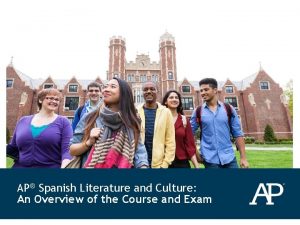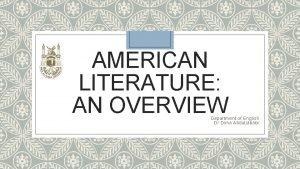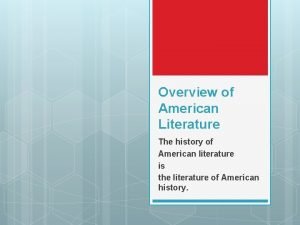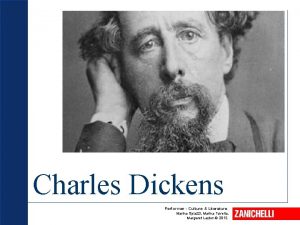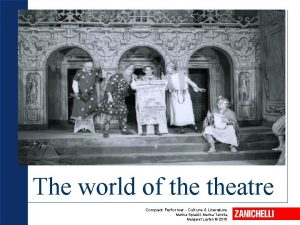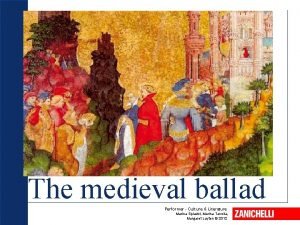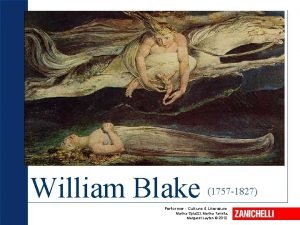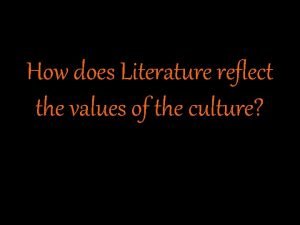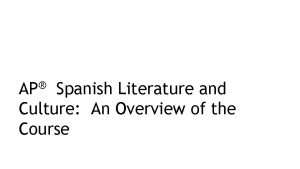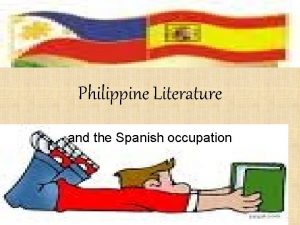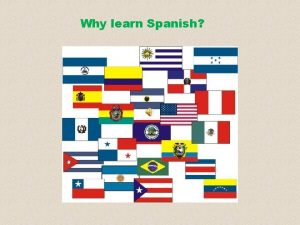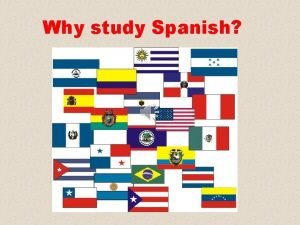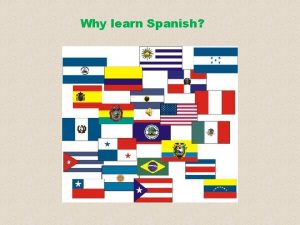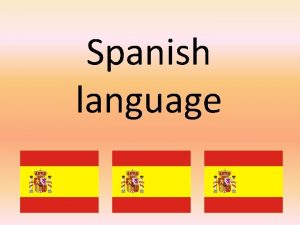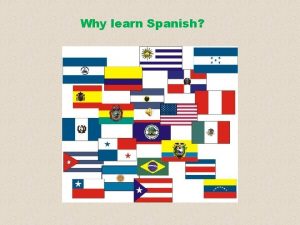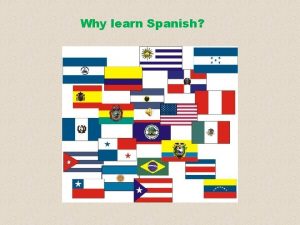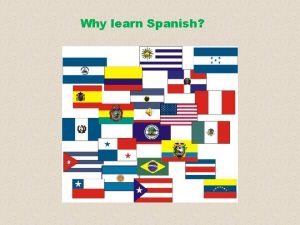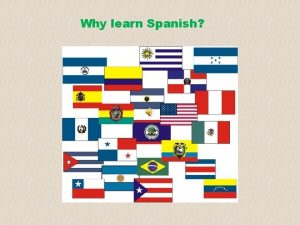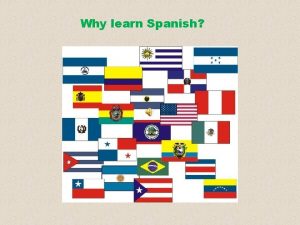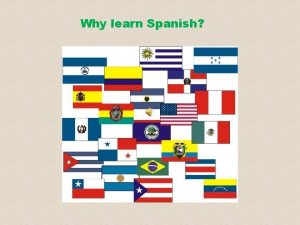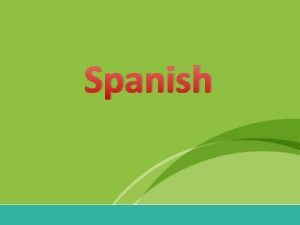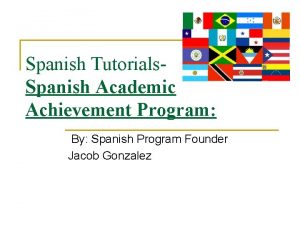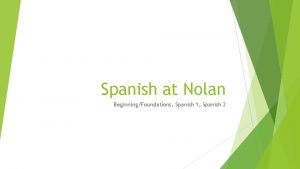AP Spanish Literature and Culture An Overview of




























- Slides: 28

AP® Spanish Literature and Culture: An Overview of the Course and Exam

AP® Spanish Literature and Culture. . . ► Aligns with the National Standards ► Reflects best practices at the college level ► Supports awarding of college credit and placement ► Prepares students for success in subsequent college courses 2

Goals of AP® Spanish Literature and Culture 3 ► Introduce students to a rich and diverse body of literature written in Spanish ► Enhance students’ abilities to read analyze literature with cultural sensitivity ► Analyze literature through literary, artistic, historic, socioeconomic, and geopolitical contexts ► Engage students in making cultural and interdisciplinary connections ► Provide students with opportunities to further develop their language skills

A Few Important Facts. . . AP® Spanish Literature and Culture: §Introduces students to cultural products, practices, and perspectives through literature §Uses a thematic approach and incorporates the study of six required course themes §Focuses on contextual analysis §Incorporates media such as works of art, film, and music 4

The Curriculum Framework ► Defines ► Lists the scope of the course the required readings ► Identifies learning objectives and achievement level descriptions ► Provides lists of targeted literary terminology for the course and exam ► Describes course 5 a thematic approach to the

The Required Reading List ► 38 required literary works by authors from many areas of the Spanish-speaking world, including works by U. S. Latino authors ► Students must read only unabridged Spanish language versions; no easy readers 6

Learning Objectives & Expectations of Knowledge Learning objectives set expectations of knowledge and abilities for students who take the AP® course. The Five Cs and Learning Objectives Communication Learning Objectives for Interpersonal Communication Learning Objectives for Interpretive Communication Learning Objectives for Presentational Communication Cultures Connections Comparisons Learning Objectives for Cultures, Connections, Comparisons, and Communities Language Usage in Support of Literary Analysis 7 Learning Objectives for Language Usage in Support of Literary Analysis

Learning Objectives & Cognitive Abilities Verbs in learning objectives reflect required cognitive abilities. Learning Objectives: Cultures, Connections, Comparisons, and Communities Ø The student analyzes the relationship between products (both tangible and intangible) and perspectives of target cultures as manifested in target language texts. Ø The student relates texts to products and perspectives found in a variety of media from the target cultures. 8

Learning Objectives & Developing Proficiency in Language Skills Learning objectives emphasize developing proficiency across the full range of language skills. Learning Objectives: Language Usage in Support of Literary Analysis Ø The student uses a variety of vocabulary appropriate to literary analysis. Ø The student uses a variety of grammatical and syntactic structures. Ø The student produces comprehensible written work by observing writing conventions of the target language. Ø The student uses pronunciation that is comprehensible to the audience in oral communications. Ø The student self-monitors and adjusts language production in oral and written communications. 9

Achievement Level Descriptions for Interpretive Communication Achievement Level 5 Students at Achievement Level 5 demonstrate an understanding of oral and written texts by analyzing main ideas and supporting details, the relationship between the structure of a text and its content, and the effect of word choice, symbolism, and imagery in texts. They analyze stylistic features and make distinctions between narrative voices and the author’s perspective in order to establish differences in meaning. They explain how the content and stylistic features of texts relate to genres and major cultural movements. They analyze themes and features of artistic representations, audiovisual materials, and spoken target language sources in relation to literary texts. They accurately use a wide variety of relevant literary terms to analyze texts, with very few errors that do not detract from the quality of their written and oral work (see Literary Terminology section). 10

Achievement Level Descriptions Example: Presentational Communication 5 4 3 2 Integrates specific, well-chosen textual examples into presentations, including references to secondary texts and brief discussions of historical and cultural contexts Cites and discusses appropriate textual examples; refers to selected secondary texts and places texts in their historical and cultural contexts Elaborates on main points and supports observations by citing examples, but these examples may not always be well described Presents main points and some details about the topic, but mostly summarizes plot and is unable to support an argument with textual examples 11

Course Themes Las sociedades en contacto La dualidad del ser La construcción del género Las relaciones interpersonales El tiempo y el espacio La creación literaria 12

Course Themes ► Teachers must address all six themes: ► ► ► Las sociedades en contacto (Societies in Contact) La constucción del género (The Construction of Gender) El tiempo y el espacio (Time and Space) La creación literaria (Literary Creation) Las relaciones interpersonales (Interpersonal Relationships) La dualidad del ser (The Dual Nature of Being) ► Teachers can choose to organize their courses thematically, chronologically, or by genres. ► Examples of these different ways to organize the course can be found in the sample syllabi available at the AP® Course Audit site. 13

Using Course Themes ► Possible 14 approaches: ► Use one or two themes to review texts at the end of each genre-based or periodbased unit. ► Start the year or semester with works that represent each theme well as a way to “anchor” themes.

Organizing Concepts ► Suggestions for working with themes and the required readings ► Not prescriptive or required Theme Organizing Concepts La asimilación y la marginación Ø La diversidad Ø Las divisiones socioeconómicas Ø El imperialismo Ø El nacionalismo y el regionalismo Ø Las sociedades en contacto 15

Essential Questions Suggested questions related to themes can be used to guide classroom investigation and design instruction. Theme: Las sociedades en contacto Essential Questions: Ø¿De qué manera las perspectivas de una cultura afectan la representación de eventos históricos? Ø¿Cómo los miembros de una minoría cultural se resisten (o se asimilan) a las costumbres y las perspectivas de la mayoría dominante? Ø¿Cómo se representan en obras literarias de distintos períodos y diversas culturas las relaciones entre grupos socioculturales (clases sociales, grupo étnicos, etc. )? 16

Literary Terminology Progression of Literary Terms (basic to advanced) BASIC General: género: narrativa, poesía, drama, ensayo; ambiente, argumento, ficción, figura retórica, héroe, imagen, lector, personaje, protagonista, público, suspenso, tema Narrativa: autor, narrador, cuento, novela; prosa Poesía: poema, poeta, voz poética; verso, estrofa; ritmo, métrica: rima consonante, rima asonante Drama: acto, escenario; comedia, tragedia; diálogo, monólogo; teatro Figuras retóricas: metáfora, símil; aliteración, hipérbole, onomatopeya, personificación 17 INTERMEDIATE General: ambigüedad, analogía, antagonista, antihéroe, arquetipo, atmósfera, carpe diem, desenlace, fábula, in medias res, ironía, memento mori, símbolo, tono, trama Narrativa: crónica, flashback, fluir de conciencia, narrador omnisciente, narrodor limitado o narrativa en primera persona, prefiguración, punto de vista o perspectiva ADVANCED General: alegoría, apología, caricatura, cromatismo o simbolismo cromático, desdoblamiento, leitmotivo, meta- (e. g. , metaficción, metateatro), parodia, sátira Narrativa: narrativa epistolar, narrador fidedigno, narrador no fidedigno, narrador testigo, narratario, parábola Poesía: heptasílabo, octosílabo, endecasilabo, Poesía: diéresis, hiato, sinéresis; verso alejandrino; arte menor, arte mayor; encabalgamiento, blanco o suelto, verso libre; cesura, estribillo, lírica, poema épico, redondilla, romance, hemistiquio; polifonía, polimetría; silva sinalefa, soneto, verso agudo, verso esdrújulo, verso llano Drama: anagnórisis, catarsis, falla trágica, Drama: acción dramática: exposición, nudo o climax, ironía dramática, pathos, tres unidades desenlace; acotaciones, aparte, comedia del Siglo de Oro, dramaturgo, teatro del absurdo Figuras retóricas: asíndeton, cacofonía, epíteto, metonimia, paradoja, polisíndeton, Figuras retóricas: anáfora, antítesis, apóstrofe, sinécdoque, sinestesia, retruécano circunlocución o perifrasis, elipsis, enumeración, eufemismo, gradación, hipérbaton Historia literaria: conceptismo, culteranismo, costumbrismo, Historia literaria: Barroco, Boom, colonial, Edad Media existencialismo, neoclasicismo, (medieval), Generación del 98, libro de caballerías, postmodernismo, surrealismo, vanguardia modernismo, naturalismo, novela picaresca, pícaro, realismo mágico, Renacimiento, romanticismo, Siglo de Oro

Glossary of Literary Terms ► Contains definitions in Spanish of each of the literary terms ► Provides examples of how terms are used in literary works from the required reading list ► Is posted on the AP® Spanish Literature and Culture Home Page 18

AP Spanish Literature and Culture Exam

AP® Spanish Literature and Culture Exam Section No. of Questions Section I: Multiple Choice Percent of Final Score Time 50% Approx. 80 min. Part A Interpretive Listening 15 questions 10% Approx. 20 min. Part B Reading Analysis 50 questions 40% Approx. 60 min. 50% 100 minutes Section II: Free Response Short Answer: Text Explanation 1 prompt 7. 5% Suggested time: 15 min. Short Answer: Text and Art Comparison 1 prompt 7. 5% Suggested time: 15 min. Essay: Analysis of Single Text 1 prompt 17. 5% Suggested time: 35 min. Essay: Text Comparison 1 prompt 17. 5% Suggested time: 35 min. 20

Types of Multiple-Choice Questions ► Listening questions (comprehension and interpretation) related to three different audio sources: ► ► ► Interview Poem Presentation ►A comparative reading exercise based on a required text and a non-required text ►A critical commentary as a reading analysis exercise 21

Free-Response Question Types ► Two short-answer questions (~15 minutes each): Text Explanation Text and Art Comparison In these short-answer questions, students must relate reading list texts to genres, periods, movements, or techniques. ► ► ► Two ► ► 22 essay questions (~about 35 minutes each): Analysis of a single text (from reading list) Comparison of two texts (one from reading list, one not from the reading list)

AP Course Audit

AP® Course Audit Information For the course audit process, teachers must submit a syllabus aligned to the curriculum framework. ► Resources available for Course Audit: ► AP® Spanish Literature and Culture Course and Exam Description ► Syllabus Development Guide ► Four Sample Syllabi www. collegeboard. com/html/apcourseaudit/index. html ► AP course syllabus submission deadline is January 31 of the academic year in which one begins to teach the course ► Schools’ year. 24 AP administrators renew approved courses each

Materials and Resources on AP Central® 25 ► Course Overview ► Course and Exam Description ► Four Course Planning and Pacing Guides ► Frequently Asked Questions ► Glossary of Literary Terms ► Practice Exam ► Course Syllabus Preparation Guide ► Four Sample Syllabi ► Online Teacher Community ► Released Free-Response Questions, Scoring Guidelines, and Sample Student Answers Visit apcentral. collegeboard. com for new resources and professional development opportunities.

Thank you! ► On behalf of the Advanced Placement Program®, thank you very much for taking the time to learn more about AP® Spanish Literature and Culture. ► We look forward to partnering with you as you build students’ success in your classroom and for the future! Thank You! 26

Audio for Practice Exam Audio Files for Section I: Part A Interpretive Listening Selection 1 http: //apcentral. collegeboard. com/apc/public/repository/APSpanish. Lit. Int. List. Sel 1. mp 3 Selection 2 http: //apcentral. collegeboard. com/apc/public/repository/APSpanish. Lit. Int. List. Sel 2. mp 3 Selection 3 http: //apcentral. collegeboard. com/apc/public/repository/APSpanish. Lit. Int. List. Sel 3. mp 3 27

Formative Assessment Models: Audio and Video LINKS Model of Formative Assessment: Focus on Using Art and Audiovisual Materials • http: //vimeo. com/1456206 • www. museodelprado. es/coleccion/galeria-on-line/galeria-online/obra/felipe-iv-a-caballo/ • http: //www. juntadeandalucia. es/cultura/museos/MBASE/index. jsp? redi rect=S 2_3_1_1. jsp&idpieza=7&pagina=4 Model of Formative Assessment: Focus on Listening Comprehension • http: //news. bbc. co. uk/hi/spanish/misc/newsid_4990000/4990336. stm Model of Formative Assessment: Focus on Listening Comprehension: Listening to Poetry • http: //tinyurl. com/baladagm • http: //youtu. be/_4 Pqws. Bak. JI 28
 Ap spanish lit reading list
Ap spanish lit reading list American literature overview
American literature overview American literature overview
American literature overview Popular culture example
Popular culture example Fed-batch
Fed-batch Difference between american culture and indian culture
Difference between american culture and indian culture Uses of selenite f broth
Uses of selenite f broth Folk culture and popular culture venn diagram
Folk culture and popular culture venn diagram Folk culture and popular culture venn diagram
Folk culture and popular culture venn diagram Site:slidetodoc.com
Site:slidetodoc.com Homework due today
Homework due today Stab culture and stroke culture
Stab culture and stroke culture Lawn or carpet culture
Lawn or carpet culture Surface culture deep culture and esol
Surface culture deep culture and esol Spanish 1 answers
Spanish 1 answers Performer literature
Performer literature Compact performer culture and literature
Compact performer culture and literature Petrarchan sonnet
Petrarchan sonnet Performer culture and literature 3
Performer culture and literature 3 William blake performer heritage
William blake performer heritage Individual culture traits combine to form culture patterns.
Individual culture traits combine to form culture patterns. Batch culture vs continuous culture
Batch culture vs continuous culture Collectivistic cultures
Collectivistic cultures What is a subculture
What is a subculture Inert organizational culture
Inert organizational culture Quality culture vs traditional culture
Quality culture vs traditional culture How does literature reflect culture
How does literature reflect culture Temas de ap spanish literature
Temas de ap spanish literature Duplo example tagalog
Duplo example tagalog
